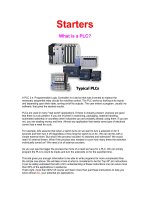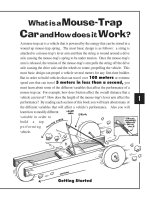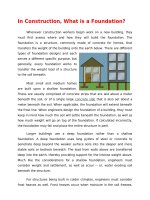What is a project
Bạn đang xem bản rút gọn của tài liệu. Xem và tải ngay bản đầy đủ của tài liệu tại đây (207.69 KB, 12 trang )
1
What is a project?
Many people find themselves working on projects from time to time, and you
may find yourself invited to lead or manage a project. Sometimes people are
asked to join a project team as part of their workload, and sometimes they
are seconded to work exclusively on a project for a defined period of time.
Some people are appointed to fixed-term jobs that are entirely concerned with
work on one specific project.
So what is a project? We use the word ‘project’ to describe something that
is not part of ordinary day-to-day work. It also indicates something that is
purposeful and distinct in character. In this chapter we consider how to dis-
tinguish a project from other work and some of the particular characteristics
of projects in HR, training and development settings. We also outline some
of the factors that contribute to successful completion of projects.
PROJECTS AND CHANGE
Projects at work can be of many different types. Some may be short term, for
example, organizing a special event, making a major purchase or moving an
office. Or they may be bigger, longer and involve more people – for example,
a project that involves developing a new service or a new function or moving
a service area to a new location. The project may be expected to deliver an
improvement to services, for example programmes and courses, or products,
for example training materials or CD ROMs. It may be expected to deliver
financial benefits to the organization in some way. In the public sector,
projects are normally expected to lead to social, economic and political
outcomes.
Projects contribute to the management of change. However, change man-
agement usually refers to substantial organizational change that might
include many different types of change in many different areas of work, while
project management usually refers to one specific aspect of the change. There-
fore, projects are often distinct elements in wider organizational change.
Example 1.1
A project as part of change management
A large hospital was merging with a smaller community healthcare
organization that offered a range of services in local surgeries, and
through home visits to patients. The development of the new merged
organization was a long and complex process, but there were a num-
ber of projects identified that contributed to achieving change. These
included:
࿖
development of new personnel policies;
࿖
relocation of directorate offices;
࿖
disposal of surplus estates;
࿖
development and implementation of financial systems for the new
organization;
࿖
development and implementation of new management informa-
tion system.
Many other changes were less well defined: for example, teambuild-
ing among the new teams of directors, managers, clinical and profes-
sional leaders and functional teams. These could not be managed as
projects but became part of a wider change management approach.
FEATURES OF A PROJECT
We normally use the term ‘project’ in quite a precise way although it can
encompass many different types of activity. It can refer to a short personal
project, for example, planning and holding a special celebration. It can also
8
Managing projects in human resources
refer to a major construction, for example, a project to build a new school. All
projects are different but they do have certain features in common. A project:
࿖
has a clear purpose that can be achieved in a limited time;
࿖
has a clear end when the outcome has been achieved;
࿖
is resourced to achieve specific outcomes;
࿖
has someone acting as a sponsor or commissioner who expects the out-
comes to be delivered on time;
࿖
is a one-off activity and will not normally be repeated.
As in any activity within an organization, there are constraints which limit
the process in various ways. For example, policies and procedures may con-
strain the ways in which things are done. The outcomes that are required may
be defined very precisely, and measures may be put in place to ensure that
the outcomes conform to the specified requirements. Once a project has been
defined it is possible to estimate the resources that will be needed to achieve
the desired outcomes within the desired time. A project is usually expected
to achieve outcomes that will only be required once, and so projects are not
normally repeated. Even if a pilot project is set up to try out an idea, the
outcome from the pilot should achieve what was required without the need
to conduct another pilot project (unless different ideas are subsequently to
be explored). Working on a project is not like ongoing everyday work pro-
cesses unless all your work is focused through project working.
PAUSE FOR THOUGHT
Which of the following activities would you consider to be projects?
Yes No
(a) Developing a new, documented induction
procedure
❏❏
(b) Establishing a jointly agreed protocol to
review the quality provided by a new
cleaning service
❏❏
(c) Maintaining client records for a home
delivery service
❏❏
(d) Managing staff rotas ❏❏
(e) Transferring client records from a card file
to a new computer system
❏❏
What is a project?
9
Yes No
(f) Setting up a management information
system
❏❏
We would say that (a), (b) and (e) fall within our definition of a
project, whereas (c) and (d) are routine activities and are therefore not
projects. In the case of (f) it is important to distinguish between the
development of a management information system (which might
benefit from a project management approach) and the subsequent
process of ensuring that appropriate data is entered into the system
and used for management, which is part of normal routine activity.
Managing or leading a project is different from taking such a role in everyday
work simply because of the limited nature of a project. There is a limit to the
length of time that anyone in the project team will be in that role. There is a
limit to the type of work an individual is expected to contribute to the project.
Some members of a project team may be selected to bring appropriate exper-
tise and others will be selected for other reasons. For example, an experienced
administrator whose everyday work is with staff induction and performance
processes might be asked to lead the project team not because of his or her
expertise in administration but because that person has demonstrated lead-
ership in his or her area of work.
AIMS
It is often said that aims describe the ultimate goal, the purpose of the project,
while objectives describe the steps that are necessary to achieve that goal. If
you ask, ‘What is the purpose of the project?’ this will help to identify the
overall aims. The aims can also be described as the vision. In some ways, using
the word ‘vision’ is helpful as it implies having a picture of success. Aims can
encompass values alongside purpose, which is helpful as it can describe the
outcome in terms of how it should be achieved. It can also identify any
important aspects of the outcome that relate to the values of the organization.
Aims can express a vision and describe a purpose, but clear objectives provide
the details that describe how the aim will be achieved.
10
Managing projects in human resources
SETTING CLEAR OBJECTIVES
It is very important to set clear objectives because these describe exactly what
you are aiming to achieve and will provide the only way to know whether
you have succeeded or not. It is often easy to agree the broad goals of the
project, but these need to be translated into objectives if they are to be used
to plan the project and to guide the assessment of whether it has achieved
what was intended.
Objectives are clear when they define what is to be achieved, say when that
is to be completed and explain how everyone will know that the objective has
been achieved. Many people use the word SMART to remind themselves of
the areas to consider when setting clear objectives:
࿖
Specific – clearly defined with completion criteria.
࿖
Measurable – you will know when they have been achieved.
࿖
Achievable – within the current environment and with the skills that are
available.
࿖
Realistic – not trying to achieve the impossible.
࿖
Timebound – limited by a completion date.
If you write objectives that include all these aspects, you will have described
what has to be done to achieve the objectives. This makes objectives a very
useful tool in a planning process. However, as planning often has to be revis-
ited as events unfold, you will also find that you have to revisit objec-
tives, and maybe revise them as you progress through the project. This is
when aims can be very helpful in reminding everyone of the intentions and
purpose.
Example 1.2
A clear objective
An objective for an HR project might be stated as:
To inform staff about the new procedure for reporting and
recording sick leave.
This objective meets some of the criteria of a SMART objective but not
others. It is reasonably specific, stating that the purpose is to inform
staff about the new procedure. However, it does not give any infor-
mation about how this will be done or when, or how success might
What is a project?
11









